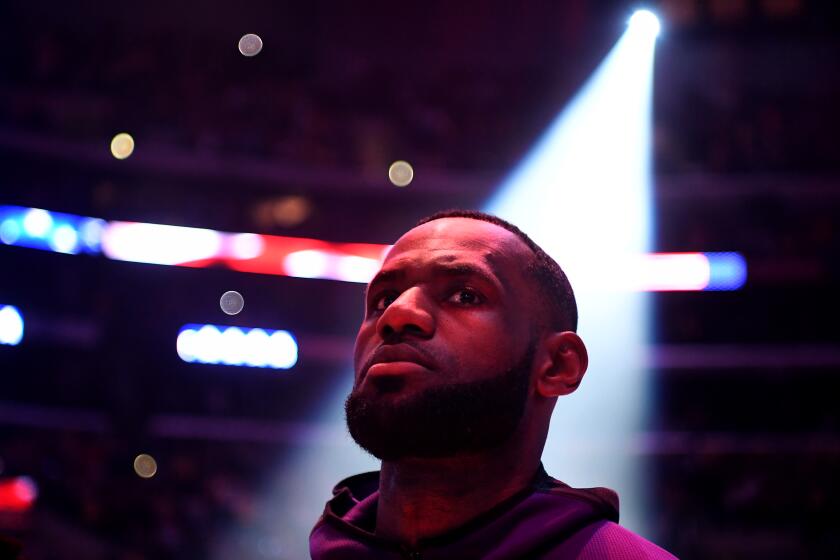Kite Flying Atop Golf World With Feet on Ground : Golf: Everybody thought this consistent contender was through at the age of 39 after he blew the U.S. Open. But now he’s the PGA Tour’s all-time leading money winner, and he did it his way--with hard work and little fanfare.
- Share via
Tom Kite isn’t as flamboyant as Seve Ballesteros. Nor is he as charismatic as Arnold Palmer. He isn’t even distinguished by winning major golf championships. Kite’s recognition comes from his consistency, and an old-fashioned work ethic.
Others hit the ball farther, and some are better putters. But when any tournament begins, nobody discounts Kite’s chances. You have to beat him. He seldom beats himself.
Only a few weeks before his 40th birthday, Kite’s methodical career has taken an unexpected turn.
With one victory, the absurdly rich Nabisco Championships at Hilton Head, S.C., in October, Kite not only became the leading money winner of the year, but also the all-time leader in career earnings.
His Nabisco win in a playoff over Payne Stewart earned him the staggering sum of $625,000 and his earnings escalated to $5,600,691, moving him ahead of Tom Watson and Jack Nicklaus. For the year, he earned $1,395,278 in official money, the most ever on the tour. However, his business associates say that figure is tripled because of foreign tournaments, bonuses he has received while representing the Ben Hogan Co., designing golf courses, endorsements and so forth.
While competing in the recently concluded Ronald McDonald Children’s Charities event at Sherwood Country Club in Thousand Oaks, Kite said the magnitude of his accomplishments are just beginning to to sink in.
“There are some pluses and minuses,” Kite said. “For sure, becoming PGA player of the year is something I wanted for a long time. But I don’t put too much stock in the career money earnings because it’s such a distorted statistic. It has changed so much in the last five years.
“However, the leading money winner for the year has some credibility. Everyone has a chance for the same thing. It’s not based on when you came along at a certain time.
“The negatives are the demands on your time. It has been nonstop. It’s all what we want and are trying to get by playing well, but it’s more than I thought it would be.”
Kite would like to reduce his schedule next year, but isn’t sure he can. The pro from Austin, Tex., said there are family considerations. He has an 8-year-old daughter, Stephanie Lee, and 5-year-old twin sons, David Thomas and Paul Christopher.
“My kids are at an age when I want to spend more time with them,” Kite said. “They’re a lot of fun to be around. I’d call home when I was on the road for three, or four weeks and the kids would start talking to me and say, ‘Daddy, why aren’t you here?’ You miss that sort of thing.”
Kite, who began his pro career in 1972 and has 13 victories, three this year, is hardly a newcomer.
Yet, he recognizes that the public has an awakened awareness of him.
“There are two reasons for that,” he said. “First, for what I did and (second) what I didn’t do.”
The negative is, of course, his failure to win the U.S. Open last June after holding a three-stroke four holes into the final round. He self-destructed and shot a 78.
“A lot of people became aware of Tom Kite because of the Open,” he said. “People hate to see that happen to anybody. I got a lot of really nice letters, some from friends and acquaintances and other people I hadn’t even met.
“After the Open, I was down quite a bit. And I know a lot of people were saying that Kite’s career is over and he’ll never win another tournament much less contend in the majors. I never thought that was the case.”
And, of course, it wasn’t. Kite came back to win the Nabisco tournament in a field of the 30 top money winners of the year.
The majors are identified as the U.S. Open, Masters, British Open and PGA Championship. Kite has come close, finishing in a tie for second in two Masters and the British Open.
“Obviously, it’s one of the things that I want badly,” Kite said. “Still, I’ve had a great career and to win a major would make it more complete.
“Also, I feel I’m a better player than some players who have won major championships and that doesn’t make me all too happy.”
Kite then mused that if he wins a major, writers will then ask him when is he going to win another one.
Such speculation doesn’t seem to bother Kite, an even-tempered, accommodating professional.
Because golf tournaments are drawn out over four days, there are early leaders and fast finishers, suggesting a scenario that there are always those who are singled out as losing a tournament in greater proportion to those who wind up winning.
“You’re going to see more of that at major championships,” Kite said. “Whoever is doing good the first couple of days is going to have more distractions than someone who is a couple of strokes back.
“If you’re among the leaders, you can’t go to the press room and knock out a 15-minute interview. It takes longer than that.
“For example, at the Open, I never got to hit any practice balls after I got close to the lead. When I came out of the interview room it was dark.
“So I think you’ll see more and more people coming from behind to win a major championship.”
Kite believes that he has won a tournament, the Players Championship, that is equivalent to a major because of a strong field and a demanding course at the Tournament Players Club at Sawgrass near Ponte Vedra, Fla.
However, he’s not making an issue of it.
In any event, Kite has his own identity now. He is no longer the “other” player from Austin, where he grew up competing with Ben Crenshaw, who joined the tour with much more fanfare.
Crenshaw won two NCAA individual titles in the early 1970s while competing for the University of Texas and shared another with Kite, a teammate.
Those who have closely followed their careers made an early prediction that because of their golf swings, Crenshaw would win more tournaments, but Kite would win more money and last longer.
As it is, the 37-year-old Crenshaw has won only one more tour event than Kite and is slightly more than a million dollars behind his former teammate in earnings.
And whereas other prominent pros, notably Watson, began to fade when they approached 40, Kite seems to have found another gear.
“I don’t see any reason why a person can’t continue to play well into his 40s,” Kite said. “To me, the way things are going, I’m just getting started.”
More to Read
Go beyond the scoreboard
Get the latest on L.A.'s teams in the daily Sports Report newsletter.
You may occasionally receive promotional content from the Los Angeles Times.










